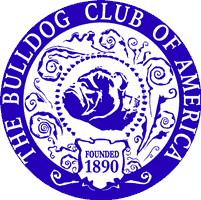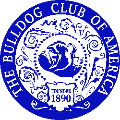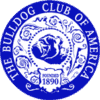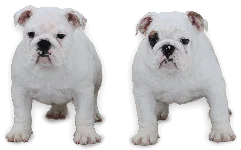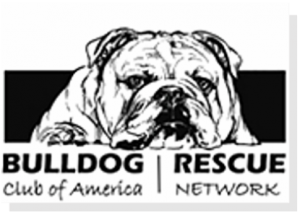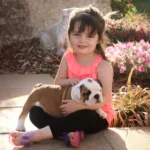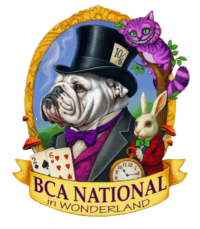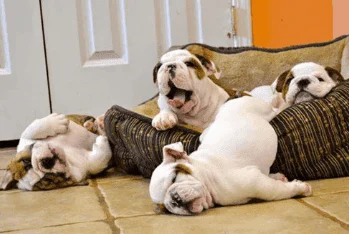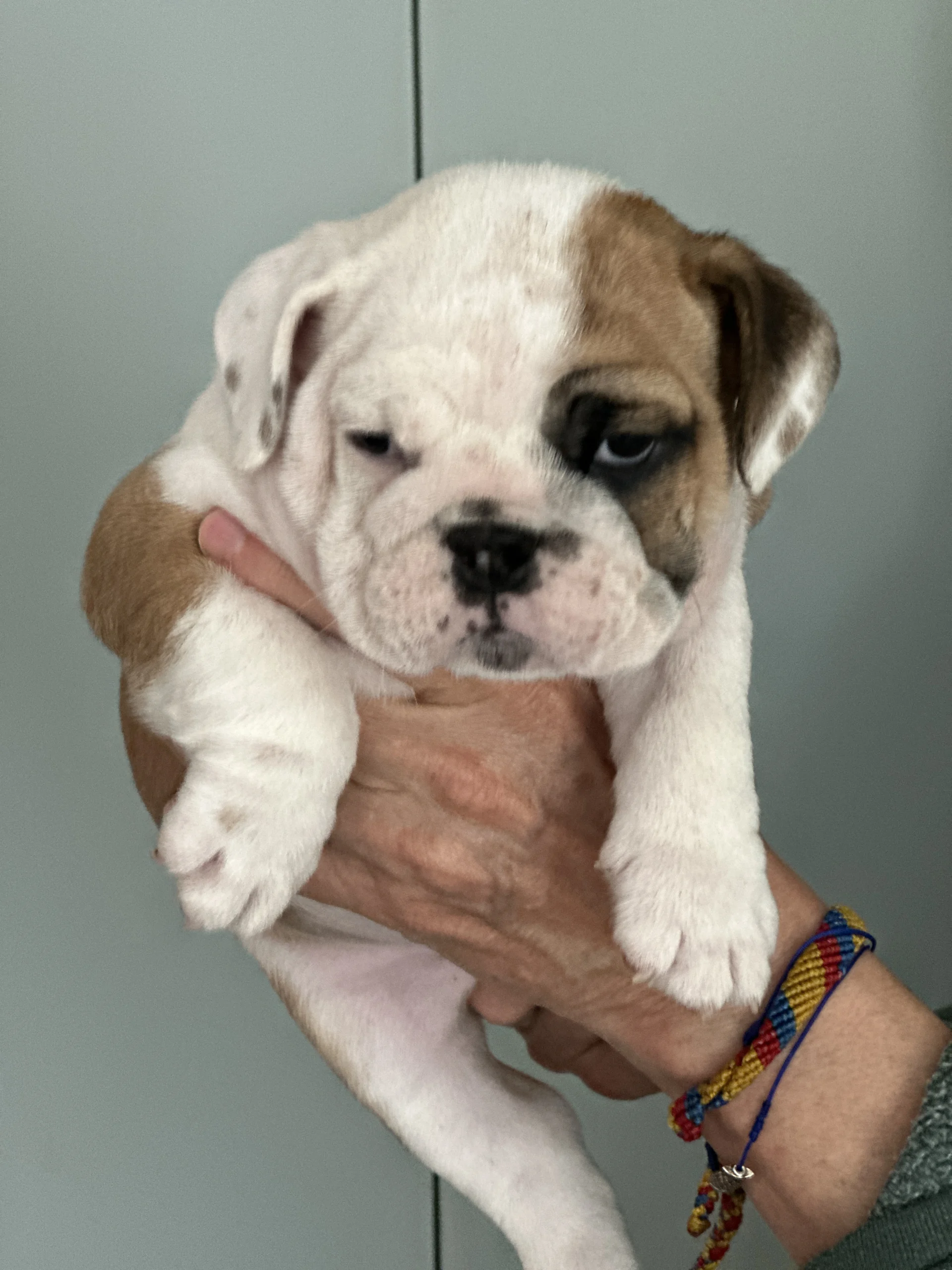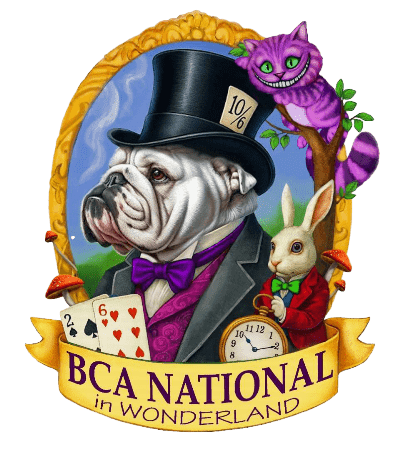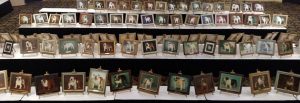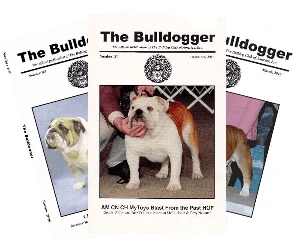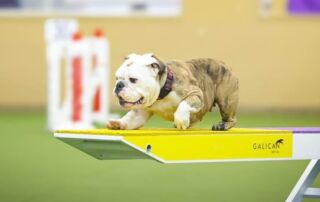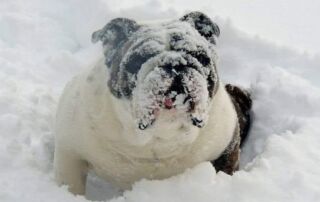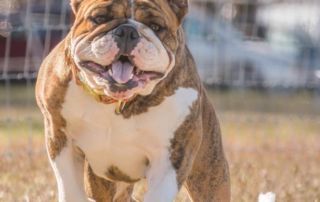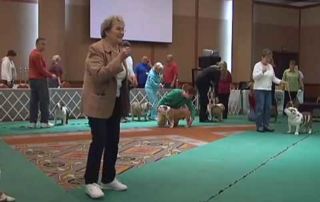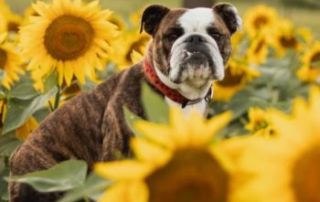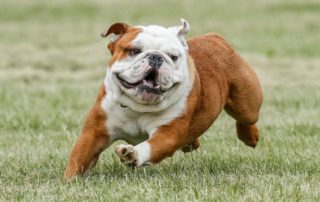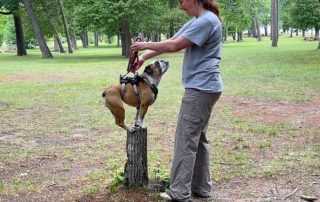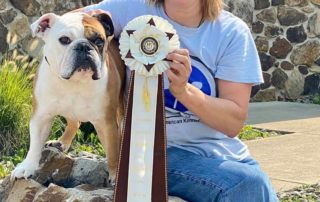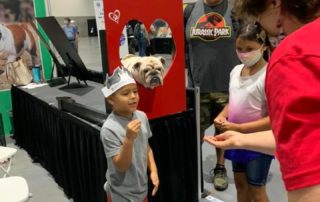Properly caring for any living animal involves a commitment to study, understand and apply existing knowledge to your specific circumstances. Bulldog Maintenance for each bulldog is different and your home is not quite like any other. Despite this, some general principles developed by breeders and owners over the years can make your care, training and enjoyment of your new companion easier and better for the health, safety, training and development of the new member of your household.
Below we provide general guidance and suggestions on how to give your new dog the best opportunity to integrate successfully into your lives and those of your family. Although no one prescription or path guarantees against potential problems, the information on these pages should help you raise a socially well-developed, sound and healthy dog.
Nurturing
As your puppy matures, you must adjust the feeding schedule to ensure that there is sufficient food and water to maintain growth and sustain hydration, but not so much as to cause digestive problems. Bulldog maintenance starts when the puppy comes home, it will need to be fed several times a day. Your breeder should provide you with information about a feeding schedule and the proper amount to feed your puppy as it matures.
In doing this you will become an aficionado of stool and urine color and consistency. You probably already know what well-formed normal stool looks like. If your puppy is being overfed, its stool will usually become loose and the color may change from brown to green or yellow. These are signs that the puppy is not fully digesting its meals. Loose stools are a potential problem because they can lead to dehydration through excess loss of fluids and may be a sign of digestive issues. Usually, increasing the time between feedings will return the stool to its normal color and consistency.
Urine is another indicators or the healthiness of your puppy. If there is no or very little urine or its color is very dark, it can be a sign of too little liquid intake or problems processing urine. If increasing liquid intake or changing feeding frequency does not show a change in volume or color of stool or urine, you should consult your veterinarian.
You should also read the sections on SOCIALIZATION, SAFETY and GROOMING in this Section.
Feeding
Your puppy will need more frequent meals until he is mature enough to cut his meals down. This should be done gradually as the dog matures. The dog may not eat all the food at each meal, but he should eat enough for his belly to be rounded. If any is left over, it can be fed to him as part of his next meal. For good bulldog maintenance our observation is that many puppies like to eat, take a stroll, and then go back to eat. Leave food out for about a half hour to be sure he's finished eating.
There is no perfect feeding schedule for all dogs. Their metabolisms differ as do their levels of activity. However, the following is a general guideline that you can experiment with:
Feeding at 13 weeks is four times a day, as follows:
- 6:00-7:00_A.M. 2 cups dry food + 1-2 Tablespoons of yogurt or cottage cheese
- 1:00-2:00_P.M. 2 cups dry food + table scraps, canned dog food or pan drippings
- 6:00-7:00_P.M. 2 cups dry food + table scraps, canned dog food or pan drippings
- 11:00 P.M. dry food - light meal
Some of his favorite additives are likely to be: canned dog food, liver, chicken liver, chicken or chicken drippings, chopped meat, evaporated milk, scrambled eggs. Eggs (well cooked) are an excellent source of protein for dogs. Yogurt and cottage cheese are also nutritious.
He will probably drop one meal (the late one) by himself between four and five months and may stretch the time between meals. He should go to two meals around six to eight months. Let him decide for himself when to cut back. There's no magic about the timing.
You should make meal time interesting to the dog. Some dogs eat well and maintain weight (easy keepers), while others need special encouragement (poor keepers). Since bulldogs should be well padded, but not fat, with no ribs showing, you must to get them to eat enough.
Whatever kind of keeper your dog is, mealtime should be fun. Call him as you begin preparing his meal, using the same words each time ("Puppy - dinner time" works fine). Talk to him while you're preparing it. This will get him interested and ready to eat once you put the bowl down. Once your dog has matured, you can switch to a lower calorie food if he has a tendency to gain weight.
Purina has a long-term relationship with BCA, since they donate to Bulldog health care research as part of the Parent Club Weight Circle Program. You puppy stay on whatever the breeder has been feeding for a while. Any change should be made slowly to reduce the possibility of diarrhea. Any equivalent high digestibility food is preferable. These are available in pet stores and many dogs do well on them. Purina One is available in supermarkets and is as good as the others. Your dog will reach adult weight at about one year of age, but will continue to mature and redistribute the weight long after that. We've had some dogs fully mature at 14-16 months; others were still growing at two years. Some dogs react differently to different dog foods. Experiment, if necessary, to find the right one for your dog.
Some dogs get bored with their food after five or six months. If that happens, switch to something else for a while. Some people recommend dog food made without preservatives. The long term effect of the additives in most dog foods is not well documented. As we are finding out about problems with human foods, we are learning about dog foods. Our dogs have done well on dog foods with the preservatives. It's up to you how conservative you want to be in this.
If you must switch foods suddenly, he will probably have loose stools for a few days. If you decide to change his food, do it gradually by mixing the two foods in shifting proportions over the course of a week until he is completely switched over.
Water
For optimum bulldog maintenance fresh water should always be available.
Clip-on water bowls are available which attach to the side of crates. In the yard, place a good size bowl in the same spot each time he is out. He will learn about it quickly and will help himself when he wants it. Check it regularly, especially in the summer, to be sure it has water. A heavy bowl, wide at the base, is best since it reduces the likelihood of accidental spillage. We've had dogs who went through periods of having to stand in their water bowls when drinking, so stability counts.
You should teach him to eat ice cubes. Start with small broken pieces; eventually he'll eat whole cubes. They consider them a treat, especially when they're hot. They work wonders in cooling off a dog that is overheated and panting and can calm dogs that are over excited. It also keeps the water bowl cool in hot weather.
When he begins teething, an Ascriptin (using child dosages from the bottle) and/or a washcloth that has been soaked and frozen will give him some relief from the teething pain.
Just as with any new situation for a person, a puppy or new dog needs to learn the rules of the household and how to get along with the other residents. Unless you clearly establish the rules and make learning them enjoyable, it will be harder to have your dog become a happy member of your family willing to obey your rules.
Bulldog maintenance includes playing which is not only fun; it teaches useful social and survival skills. It helps form a bond between you and your puppy. Your dog is a pack animal and you and your family members are part of his pack. It is important that he see himself as subordinate to each of the human members of the pack. His early play will teach him this, although he will try to assert his dominance as he gets older, just as teenagers try out the limits of their parents rules.
Playing and fun walks on a leash are enough for now. Try to spend at least 15 minutes playing with him actively several times each day - but don't overdo it. He's growing rapidly and you don't want to put stress on his still-developing bones. At this point he will enjoy lots of active play and may not have the sense to know when to stop. Use common sense - if he looks like he's overdoing it, he probably is. Pick him up and cuddle him while he protests; he will probably fall asleep in your arms quickly. He still takes several longish naps in the morning and afternoon.
Just like children, dogs need to be old enough to reliably train to eliminate where and when you want them to. A very young puppy will not be able to succeed and you need to have patience training them and letting them mature to the point that they are physically mature enough to do what you want.
As a start, you need to take your dog out as soon as it wakes up and after each meal. That is when they most frequently have to go. Stay with them outside until they eliminate and praise them. A good reward goes a long way in getting the dog to learn the behavior you want.
If they have an accident in the house, don't stick their noses in it and tell them they are bad. Unless you catch them in the act, they won't connect your message with their behavior. If you do catch them in the act, immediately take them outside and praise them when they finish will help more quickly house train your puppy than punishment.
Although getting outside and exercising is important at all ages, at about six months he should start regular exercise. Bulldog maintenance would require starting to take him for longer walks, gradually building up the distance. Start with about a half-mile and gradually build up to about 2 miles a day. The dog should enjoy his walks - go in different directions and give him some time to sniff and explore. He should work towards a 30-45 minute solid trot, but he won't start at that level. Like any exercise program, gradual increase is the key to sound conditioning.
Of course, watch out for the summer heat. In the summer walks should be in the early morning or late evening, depending on the temperature and your schedule. If the day is oppressive, skip the walks and play in the air-conditioned house instead.
In the winter, again use common sense. If it's too cold for you, it's too cold for him. Salt and chemicals used to melt snow will bother his feet tremendously. They can cause or aggravate inter-digital cysts (between his toes), so wash his feet thoroughly if you walk in a salted area. If possible, avoid such areas. Watch him to decide if a coat is necessary. They can be helpful for young dogs, elderly dogs and dogs who aren't feeling quite well. A mature, well-padded Bulldog probably won't want or need one except on the coldest days.
Puppies like hard, solid rubber toys and puppy Nylabones. Do not give rawhide toys, soft rubber squeaky toys, or any toy with a squeaker or small part which could be chewed off or dislodged. If you let him play with old socks, he will raid the hamper for the rest of his life. When he's older, he'll swallow the socks whole, certainly making him sick and possibly killing him.
In addition, teaching a Bulldog to play pulling games may be fun for only a while. One day you are going to want your dog to release something he's holding and the famous Bulldog grip will not let it go unless he's trained to release as well as pull. For proper bulldog maintenance this will be especially important to teach if you want to try your hand at obedience showing.
Do not give bones of any kind. Bulldogs, even puppies, have especially powerful jaws and can splinter a large bone which may cause severe internal bleeding. Do not teach the dogs to play with sticks - they can splinter even sizable branches quite easily and can puncture their mouths with splinters.
Don't give the dogs old shoes or old clothes to chew - they can't tell what is old from what is new and expensive and your absolute favorite. If you leave shoes around, the puppy will chew them - they prefer to chew expensive shoes when given the choice, although some dogs specialize in lifts and heels.
Bulldog games generally involve chewing - they will play with chew toys throughout their entire lives. Your puppy likes to chase balls (hard rubber or Nylabone only) or other toys when thrown where he can see them. He doesn't catch them - most Bulldogs aren't too good at that - but he likes running, pouncing, shaking and carrying toys. Most Bulldogs like to play tug-of war - just make sure that you teach the dog to release what's in its mouth on command when it's young or you may have a problem when it's older.
Most Bulldogs love wading pools and water. He'll probably like the hose or sprinkler. Just make sure the water is shallow and the puppy can get in and out easily. Supervise - don't let him swim in the lake or river without supervision. Even though Bulldogs swim instinctively, they shouldn't be allowed in water that's more than elbow deep unless supervised closely.
We've heard of Bulldogs drowning when there was any kind of current or wake from boats. Their breathing makes it easy for them to inhale water. In addition, if they panic, swelling of the throat tissue could result in closing off the airway even if they don't inhale water. If you take him out in a boat, which we don't recommend, a life jacket made for dogs is a necessary safety precaution.
Be careful about games near stairs. He may accidentally fall down and injure himself or may decide to explore stair climbing before he is ready. Dogs have fractured their shoulders falling down stairs. Bulldogs can take a lot of pain and not show it; an undiagnosed injury may cause trouble for the rest of your dog's life. You can teach him to climb stairs when he's ready, but you need to supervise him whenever he has access to stairs until he really has it down pat. Given their structure, bulldogs may have mor eproblems going down staris than going p them. Again, he has no real fear of falling at this age.
Even if you think his mouthing behavior is cute as a puppy, you won't in another two months - at that point you'll have a much harder time teaching the dog and the nips will turn into real bites. Bulldog maintenance means you need to teach that chewing and biting people is unacceptable. This can be done by sharply saying their name and "NO" when they chew. You can detach the puppy by putting a finger on each side of his mouth in front of where the jaws attach and squeezing progressively less gently until the mouth opens.
Another trick is to fold his lip over his teeth. Biting himself a couple of times will prove discouraging. It shouldn't take too long (a week or two) before they learn not to bite. In more difficult cases you can coat your hand or arm with a product like Bitter Apple. The dog will quickly learn that it doesn't taste good when he bites people.
This training is best done by an adult. Consistency and firmness are the keys to successful training. A mature, motivated child of 11 or 12 can probably learn to handle the puppy consistently, but younger children should be supervised until they and/or the puppies have developed some self-control. Ultimately, your puppy will make a wonderful child's pet, but he has some maturing to do first.
In addition, your dog should be taught to permit people, especially children, to take food from his bowl while he is eating. Some dogs may be protective of their food and need to learn not to nip or bite when approached while eating. By controlling the situation, you can safely teach your dog to become a good member of your household.
Children like dogs and Bulldogs are great with children. However, they both need to learn how to get along with each other. Never leave young children with unsupervised dogs. Both can be injured as a result of not understanding that dogs are not people and that people are not dogs. As mentioned above, a dog may need to learn not to defend its food from children. Children need to learn that the dogs don't understand what they are saying and won't listen to what they are told at a young age. Impulsive behavior by both children and dogs can lead to problems and potential injury. Be sure to adequately supervise their interaction until they both understand how they should interact.
Keeping your Bulldog Safe
The first thing you must do before bringing your puppy home is to make the place safe for and from him. Puppies are wonderful, but unsupervised in a normal home, they can wreck havoc way out of proportion to their size. To ensure minimal damage to your home and maximum safety for your puppy, a few changes will be needed. This is very similar to making a house safe for a crawling infant - which, after all, it what your puppy is.
Puppy's Home
For most people, the ideal puppy-proof room is the kitchen or spare room. Ideally, the room should have linoleum or tile floor (accidents will happen and the easier to clean up, the better). However, the floor should not be slippery. A slippery floor could cause your dog to injure himself.
Puppies chew anything that catches their attention. All electrical outlets, cords and plugs should be out of reach. Child proof plugs can be inserted into unused outlets. All floor level outlets should be blocked by something. Any furniture in the room should be considered expendable - it will be usable after the puppy is grown, but its edges may be battered. It's clearly not a place for your favorite antiques, heirlooms, or breakable china.
Bitter Apple is a fairly effective short term deterrent to chewing. It tastes awful (although some dogs like the taste), but it wears off quickly. The liquid kind can temporarily change the color of wooden furniture; there is a cream for that purpose. However, the best way to avoid damage to furniture is to keep the furniture and the puppy apart unless you are there to supervise and correct misbehavior.
Anything the puppy can carry and chew should be removed from the puppy's reach - books, magazines, and shoes seem especially tasty - unless you want them carried and chewed. The contents of open or openable (even if that means chewing through a box) household supplies, laundry hampers, or garbage pails can provide endless hours of entertainment for your puppy - or can poison or kill him. Remember, it's just like guarding your home from a curious, inquisitive and impish child.
Assume that the puppy will find a way to pull down or topple anything he is interested in. Blankets, towels, long tablecloths (and anything that was on them) will wind up on the floor. They will chew pillows and scatter foam or feathers everywhere. This stage is usually temporary (although some dogs seem to get stuck here), but every dog does go through it for some period before maturation and training have their effect.
Other Areas Around Your Home
Your puppy should not roam free unless you're there to supervise. While you don't have to go to extremes to puppy-proof every room, you should make sure there are nothing breakable or chewable at his eye level.
Remember, it's just like child-proofing, except his tastes are more exotic. Everything he notices will wind up in his mouth at some point. Don't leave shoes lying around and be compulsive about picking up coins, screws, bottle caps, etc. You will be amazed by the variety of things you wind up taking out of your puppy's mouth . Some dogs love to pick up pebbles outside and bring them in to chew. Sometimes you won't be sure if the sound from his cheeks was a pebble or his brain rattling around.
Decide before he arrives about your rules about dogs on furniture. Make sure that every family member and guest enforces the rules consistently. He can't be blamed for not learning rules which change from person to person. If you decide to allow the dog on furniture, you will find sturdy, earth toned, patterned fabrics stand up best.
There's no right or wrong about this issue (but it's hard to resist their pleas to cuddle in your lap when you're sitting on a chair or couch), just decide what makes you comfortable and be consistent. You need to make the same decision about your bed. the rules are yours to enforce -- dogs can be allowed on furniture, but not on the bed, or whatever combination you want. Just be consistent in your rules.
Stairs and pools can pose major safety hazards. Puppies have no sense of their own capabilities and no fear of falling. They will step off a step and roll or tumble down the rest of the stairs or step into a pool that's too deep and take an unplanned swim. Your dog can permanently injure or kill himself this way.
To the extent possible, stairs should be blocked off until the puppy has learned to climb safely up and down the stairs under your supervision. Some people put gates or doors at the top of all stairways - either full doors or half doors - to prevent accidental falls. Bulldogs have heavier front ends than hindquarters. This can cause them to overbalance and fall (going down stairs or into a pool, for example) until they get a good sense of balance and how to move all their parts together. This takes learning and time. Be sure to supervise your puppy inside and outside to prevent accidents.
Be careful about games near stairs. He may accidentally fall down and injure himself or may decide to explore stair climbing before he is ready. One very nice show dog fractured his shoulder falling down a flight of stairs when he was three months old. Bulldogs can take a lot of pain and not show it, but he could carry the limp with him the rest of his life. You can teach him to climb stairs when he's ready, but you need to supervise him whenever he has access to stairs until he really has it down pat. Again, he has no real fear of falling at this age.
Bulldogs have heavier front ends than hindquarters. This can cause them to overbalance and fall into a pool until they get a good sense of balance and how to move all their parts together. This takes learning and time. Be sure to supervise your puppy to prevent accidents.
Outdoors
Most Bulldogs love wading pools and water. He'll probably like the hose or sprinkler. Just make sure the water is shallow and the puppy can get in and out easily. Supervise - don't let him swim alone in the lake or river. Even though Bulldogs swim instinctively, they shouldn't be allowed in water that's more than elbow deep unless supervised closely.
Bulldogs can swim. However, if they can't get out of a pool by themselves, they can easily drown. The same precautions need to be taken around pools for dogs as for young children. Secure gates and fences are critical. Many bulldogs love water. People put small kiddy wading pools in their yards in the summer to provide a place for the dogs to cool off and play.
Weather is also a factor. Obviously on on very warm days, you want to make sure your dog has both shade and water when outside and that you supervise your dog to make sure your dog doesn't overheat. In very cold weather, remember that your dog may have a coat, but it may not be warm enough to protect the dog if outside for a long time or in extreme conditions.
Storms can create their own dangers from water, winds and lightening. The National Weather Service and the Federal Emergency Management Agency have published a pamphlet on the dangers of storms. You can view it by clicking here.
Around Children
However, this does not mean that young puppies can be turned loose to play with children unsupervised or that children should be left alone with dogs unsupervised. The puppy is a baby himself now. He doesn't know when to stop playing - he'll play till he drops. They are adorable, but undisciplined. Puppies wrestle, chase, chew on and bite each other when they play - even at this age they have a strong bite and sharp baby teeth. At this age, he hasn't learned the difference between other puppies and people, so he'll play this way with children. This could be threatening to the child, if the puppy is not managed carefully by an adult.
A similar rule applies to children with older dogs. The child may inadvertently do something that the dogs interprets as aggressive or may hurt then dog while playing with it. Dogs and children need close supervision when together to prevent unintentional harm to either.
Toys
Do not give bones of any kind. Bulldogs, even puppies, have especially powerful jaws and can splinter a large bone that will cause severe internal bleeding. Do not teach the dogs to play with sticks - they can splinter even sizable branches quite easily and can puncture their mouths with splinters.
Don't give the dogs old shoes or old clothes to chew - they can't tell what is old from what is new and expensive and your absolute favorite. If you leave shoes around, the puppy will chew them - they prefer to chew expensive shoes when given the choice, although we knew one dog that only ate lifts and heels.
Bulldog games generally involve chewing - they will play with chew toys throughout their entire lives. Your puppy likes to chase balls (hard rubber or Nylabone only) or other toys when thrown where he can see them. He doesn't catch them - most Bulldogs aren't too good at that - but he likes running, pouncing, shaking and carrying toys. Most Bulldogs like to play tug-of war - just make sure that you teach the dog to release what's in its mouth on command when it's young or you may have a problem when it's older.
Proper grooming is essential to keep you puppy healthy, free of parasites, and socially acceptable to you and your friends. Most grooming tasks are easy to do and take little time if you perform them at regular intervals.
Bathing
Bulldogs fall into two groups: those who love water and those who can't stand it. Luckily, most Bulldogs love water and can be taught to enjoy the fun of a bath.
At this age, it's easiest to bathe him in the kitchen sink. Put a rubber bath mat on the bottom of the sink and use the spray attachment to wash and rinse. Test the temperature often if the temperature tends to vary. Keep one arm around him at all times so he can't suddenly climb out. Be very careful of getting soap in his eyes, nose and ears. Mineral oil can be placed in the eye to protect it from accidental soaping. Your dog can be dried with a towel or you can use a hair dryer set at low power and temperature. In warm weather, you can leave the coat slightly damp. In cold weather, do not let your dog go outside until the coat is fully dry. Just like with clothes, darker colors hide the dirt better, so dogs with dark colors are easier to keep clean looking. Dogs with lots of white look flashy, but they are show dirt easily. Most show dogs are bathed once a week - more often in muddy weather. If you're not showing your dog, let common sense be your guide - over bathing can remove natural oils which are necessary for a healthy coat. There are colored shampoos to make coats glisten. There are several available of each type and all are equally good at keeping the coat soft, bright and shiny. Shampoos for white dogs are available for white and light colored dogs, as well as for dogs with white markings.
During the spring and summer, we recommend you use a flea and tick shampoo if you're in an area where they are a problem. They don't eliminate fleas completely and are of only some use against ticks on the dog. They can kill adult fleas immediately and make a dramatic difference - both to your dog and to you if its keeps your house from becoming infested. A flea comb and a rubber curry brush will help loosen dead hair and remove dead fleas in the bath.
Brushing
Brush him 2-3 times a week for 10 minutes and he'll always look beautiful. Our dogs seem to love it. If he's shedding, use a rubber curry brush first. Be sure you take the opportunity to inspect him while you're grooming. This is your chance to spot problems before they become serious - cuts, scratches, bare patches, flea bites, or skin conditions are easier to correct before they lead to infections or hair loss.
Wrinkles
His face needs regular care because of its construction. Keep the wrinkles clean - particularly those over the nose. Use a cotton ball dipped in peroxide to clean the wrinkles thoroughly. Then powder the area with corn starch or baby powder to ensure proper drying - of course, be careful to avoid getting powder in your dog's eyes. Depending on the dog, you may need to do this daily or weekly. Food or dirt gets trapped easily in wrinkles, causing discoloration, flaking and dermatitis. Rub his nose with a small amount of Vaseline. This will prevent his nose from getting very dry and hard as he matures.
Dermatitis is very common in wrinkles. The symptoms are inflamed, red, angry looking skin - it may be moist. Clean gently and often with a cotton ball soaked in warm water. Dry gently and use an antibiotic ointment. It should clear up in 4-5 days with this treatment. Acne is quite common in young bulldogs. It's just like people acne. Keep the effected area clean - use peroxide unless it's near the eyes.
Tear Stains
The enzymes in some dog's saliva and tears also cause a reddish or brown discoloration in the wrinkles under their eyes and may extend onto their face. This happens more in some dogs than others, usually the white ones where it shows up more. If your dog is prone to such discoloration, you can reduce it by frequent cleaning, but you probably won't ever get it completely white. That's why regular cleaning is important. The stain can be lessened by bathing the area in a diluted solution of hydrogen peroxide. Be careful to keep the peroxide out of the eye. Mineral oil can be put in the eye first to protect the eye.
Although its exact cause is unknown, tear stains may be due to a low grade infection which worked its way up to the tear ducts. Success has been shown with broad spectrum antibiotics like Tetracycline. This works because it reduces the infection and the Tetracycline is secreted in the tears, combining with the part that causes the stain. However, you don't want to give any long term antibiotic therapy without consulting your Vet and Tetracycline, in particular, is known to stain teeth when given to humans whose bones and teeth are still in development.
Ear Cleaning
Clean them once a week using a cotton ball moistened with Listerine. If they look red and sore, put a few drops of something like Panalog in them every day and clean gently until they are back to normal. Bulldogs can tend to collect a lot of ear wax, so adjust the schedule to his particular needs.
If the ears are red and sore and the Panalog doesn't improve the situation in four or five days, see the Vet - he may have ear mites. If there is a bad smell from the ears or they produce a lot of dark wax, your dog may have ear mites. They are easy to deal with, but should be taken care of with medication you'll get from your Vet.
Your dog's ears should be set to conform to the Bulldog Standard. The ears are now set in the proper shape - what are called Rose Ears. When dogs teethe, they may drop their ears and the ears may need to be reset. Note how the ears fold back on themselves. To ensure that his ears remain the proper shape, you should set them with Surgical Adhesive (or Eyelash Adhesive, which is serviceable but not as good). Place a small amount of the adhesive in the external creases of the ear and hold the ear in place for a few minutes while it sets. Then put adhesive on the tip of the ear and place it where it will naturally fall.
Nails
Your puppy's nails should be cut once a week. They should be short enough that you don't hear clicking on the bare floor when the dog walks. It is easier to do this frequently, a little at a time, rather than try to lop off all the excess in one pass. Avoid cutting the quick, which hurts him and causes bleeding. If you cut the quick, touch the end of the nail with liquid styptic - it stops the bleeding fast.
It may be easier for one of you to hold him while the other cuts the nails. Putting the dog on his back cuts down resistance - it is a submissive position for a dog. He will probably resist having his nails done - every Bulldog does so to some extent at first. Don't believe him if he wails (but check to see you didn't cut the quick). Some nails are clear, while others are black. With black nails, you will have a hard time knowing when you get close to the quick. Don't worry. Just trim them gradually until you reach a point where a white portion of the central shaft protrudes a bit - this is the outer covering of the quick. You will see dry, horny white when you first cut - this is not the quick. Experience is the best teacher.
Tails
Bulldog tails are either straight down or twisted and close to the body. The twisted ones predispose the area under them to problems. You must make sure that the area under the tail stays clean and dry. This means that you wash and dry the area under the tail thoroughly with each bath. It's easiest if you just use your hands, but a washcloth will work if you want to use one.
Inspect the area under the tail when you dry him. It's possible for him to get dermatitis under his tail just like in the wrinkles. Make sure you check the underside of the tail itself, as well as the part of the body it rests against. Treatment is similar to treating the skin folds. If it looks red, angry and moist, wash it 2-3 times daily with warm water. Dry the area gently and put Panalog on it. If your dog has diarrhea, make sure to keep the area clean and dry, using Panalog as needed. He will be very sore and may resist, but he needs your help.
Dogs generally travel well. If you take them on short trips in your car or when you go away overnight, they get used to traveling with you. For day trips, you can leave your dog in a safe place within your house without any problems once it's properly trained.
Some people don't like traveling with pets and prefer to leave them in a boarding kennel. There is nothing bad about this and your dog won't hate you for leaving him for a short period. As long as you have checked the kennel out in advance and know they can take care of your dog properly, the decision to kennel versus travel with your dog is personal, based on your life-style and needs.
Cars
They mostly lie on the car seats, sleep in their crates or watch out the windows. However, some dogs experience car sickness and even the hardiest traveler can have an occasional bad day. If you're traveling on vacation or going to a novel, and possibly exciting, situation be prepared: carry water, ice and lemon juice with you. Paper towels, in case of a need for a clean-up, are good to have along. The small Igloo ice chests work well along with a Thermos bottle. Just be sure to supervise the dog well.
Some short rides can accustom the dog to the car. They will enjoy going on errands with you and will see going out to the car as a fun experience. Dogs even take their owners to the car when they go for walks - just to let them know they are willing to go for a ride if you want to take them. Decide where the dog will ride from the beginning. They should not be allowed to climb all over the car. This is dangerous for everyone - it's hard to stop the car when your dogs head is under the brake peddle and it's distracting to have your face washed in heavy traffic.
Never allow your dog to ride with his head out the window. This can cause eye injuries, many of which are serious, or head injuries, which can be fatal. One other car precaution - NEVER leave your dog in the car with the windows closed when it's warm out. The interior of a car can heat very quickly, even when the outside temperature is in the seventies. Excessive temperatures can lead to heat stroke and death. In many jurisdictions, this is a crime and the police can break into your car to "rescue" your dog, even if he isn't in trouble.
Planes
Bulldogs, except puppies, are too large to travel in the passenger section of airplanes, where all pets must fit into under-the-seat carriers. The only way to transport your dog aboard a plane is in the baggage section. If you can avoid plane travel for your dog, we would recommend it. The stress of plane travel, the chance of dehydration, and the possibility of hyperventilation make plane travel potentially dangerous for Bulldogs. Dogs have died from complications in plane travel.
If you decide to take your dog on a plane, there are several precautions you should take. Book a non-stop, direct flight, if possible. The airline will require a sturdy flight carrier designed to their specifications. You should be sure that your dog has water, in a non-spill container and a toy. It is helpful if your vet prescribes a mild tranquilizer for the flight. You should arrive early enough before the flight that you can check your dog in without having to rush, but not too early. The airline will let you know how much time you will need. Most airlines have air-conditioned areas where animals wait before loading. You should see where animals are kept before you choose your airline. Animals are usually loaded last and taken off first to lessen the danger to them. You should pick your dog as quickly as possible when the flight ends.
A problem can occur when your dog sits in the hot sun waiting to be loaded or when there is a delay in take-off after loading has been finished. Unfortunately, there is some carelessness and, at times, some unavoidable delay. Although the compartment in which your dog will ride is pressurized on the longer, high altitude flights, the air circulation system is the same as the plane's. It can sometimes get warm and stuffy when the planes back up before take-off. A problem can also arise when the airplane is delayed in landing or diverted to a new airport, resulting in delayed feeding and water replacement. Despite the potential problems, many people don't want to leave their dogs in a kennel and do successfully take them on plane trips with them. Just approach the trip with adequate planning to be sure it's a safe, comfortable ride for your dog.
Hotels and motels
You can take your dog along on vacation. Many hotels and motels accept guests with pets. All states now permit pets in hotel rooms. Chains publish directories that contain this and other information about their hotels. However, you should check in advance with the specific hotel, since directory information is not perfect.
Most hotels that permit pets want them kept in a crate when you're not in the room. This is a good idea for their safety and the safety of the room. You don't want to pay for chewed furniture and you don't want to search for your dog because the maid runs away leaving the door open because he playfully comes bounding over as she enters the room. (Don't even think about your dog getting territorial in the hotel room.) Many motels and hotels now have dog friendly policies. You can check on their web sites to see whether they have restrictions on pets or charge a pet fee.
Many campgrounds permit pets and there are directories published for these which are available in most bookstores. As with hotels, check with the campground to see if the policy is still in effect. Traveling by camper with your pet can be enjoyable, just as long as you use common sense. Remember, almost all campgrounds require pets to be on leashes and leash laws vary from state to state. Your pet can generally stay outside your camper in an x-pen, which permits some degree of freedom while containing him.
Local Dog Laws
Several states and localities are enacting dangerous or vicious dog laws. Some are generic laws which punish bad conduct by the dog. Others are breed-specific legislation which prohibit the ownership of certain breeds or types. The generic laws should pose no problem for the well-behaved traveling dog.
Breed-specific laws can be a problem. Breed specific laws do not distinguish between a well behaved dog under it's owners control and an aggressive, uncontrolled dog. If it is the wrong breed, or if the enforcement agent thinks it is the wrong breed, you could have a problem. Many of these laws needlessly target dogs in the bull breeds: e.g., American Staffordshire Terrier, Bull Terrier, Staffordshire Bull Terrier. Some people have had their well behaving pets seized by overzealous officers. You should check in advance to determine where there are breed-specific laws in the places you will be visiting and should carry copies of the AKC registration listing the dog's breed.
Most states have laws requiring health certificates for dogs entering the state. Sometimes there is a grace period when you can enter without a health certificate; other times there isn't. You should check the web sites of any states you plan to travel through with your dogs to determine whether health certificates are required. You should be aware of the possibility of breed-specific laws being enacted where you live. The AKC and local clubs oppose breed specific laws and are working to eliminate them. You can contact the AKC for more information on this issue and read the ADVOCACY pages on this site.
